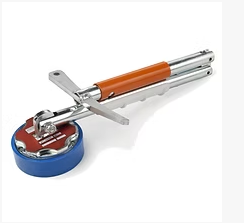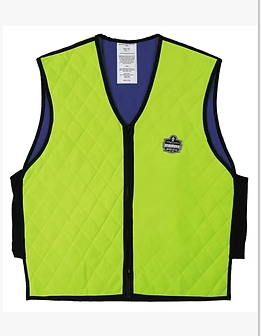What Techniques Are Used to Cool the Body Using Cooling Vests
- Techniche Team
- Jul 3
- 5 min read
Updated: Jul 31

When it gets super hot outside and the heat starts to feel unbearable, everyone starts finding ways to cool down, which becomes really important. To overcome this problem, cooling vests are becoming increasingly popular. These vests are designed to help keep your body temperature at a comfortable level, even when it's scorching outside.
They work in different ways, from simple methods like evaporative cooling, where water evaporates to take away heat, to fancier stuff like using special materials that can change from solid to liquid and back again, or even using powered systems to cool you down actively.
Here, we'll explore vest cooling techniques, where they can be useful, and how to use them effectively. Understanding how they tick can help us see why they're important for staying healthy and feeling good, whether you're working hard or just having fun outdoors. So, let's take a closer look at cooling vests and see how they're making life cooler and more comfortable for all of us.
Let’s get started!
Overview of Cooling Vests
Cooling vests offer a practical solution for individuals working or exercising in hot environments, providing both comfort and safety by helping to mitigate the risks associated with heat stress. Whether through active or passive cooling mechanisms, these innovative garments contribute to improved performance, productivity, and overall well-being in challenging conditions.
Types of cooling vests (active vs. passive)
Active Cooling Vests: These vests utilize technology such as battery-powered fans or circulating water systems to cool the body actively. They require power to function but offer continuous cooling for extended periods. Active cooling vests are often favored in high-intensity or prolonged heat exposure situations.
Active Cooling Mechanisms:
Fan-based Vests: These vests incorporate built-in fans that draw air over the body, facilitating heat dissipation through convection. The airflow enhances sweat evaporation, which cools the skin surface. These are recommended where the ambient temperature is around the skin temperature
Circulating Water / Vortex Tube Systems: Water-based cooling vests circulate chilled water through tubes lining the vest. As the water absorbs body heat, it is pumped to a cooling unit, where it is cooled before being recirculated. This continuous process helps maintain a stable body temperature. Compressed ir based systems utilise a vortex tube to create a stream of cold air which is circulated over the user’s body.
Passive Cooling Vests:
Passive cooling Technique relies on materials with high thermal conductivity or phase change materials (PCMs) that absorb and dissipate heat from the body without the need for external power. They are lightweight, versatile, and suitable for environments where access to power is limited or impractical. Passive cooling vests are available in various designs, including evaporative cooling vests and ice pack vests.
Passive Cooling Mechanisms
Evaporative Cooling: Evaporative cooling vests use materials that retain moisture, such as absorbent fabrics (SAF, PVA) or polymer crystals. When soaked in water and worn, these materials slowly release moisture through evaporation, drawing heat away from the body and providing a cooling sensation.
Phase Change Materials (PCMs): This Phase Change cooling Technique stores and releases thermal energy as it changes from one phase to another (e.g., solid to liquid). PCM cooling vests contain packs filled with these materials that absorb excess heat from the body, keeping the wearer cool. These vests are effective for maintaining a constant temperature for a prolonged period.

Techniques for Cooling the Body Using Cooling Vests
Cooling vests are designed to help regulate body temperature by providing a cooling effect through various mechanisms. Here are some standard techniques used in cooling vests:
Phase Change Material (PCM) Vests: These vests contain pockets filled with a phase change material that absorbs heat when it melts and releases it when it solidifies. They can maintain a constant temperature for a specified duration. PCM can be organic or inorganic (ice, paraffins, salt hydrates etc.)
Evaporative Cooling Vests: These vests use evaporative cooling technique to reduce body temperature. They are made from materials that retain water and allow it to evaporate slowly, drawing heat away from the body in the process. These vests need to be soaked in water before use.
Thermoelectric Cooling Vests: These vests utilize thermoelectric technology to create a temperature difference between two surfaces. They typically require a power source and can provide consistent cooling for extended periods.
Liquid Cooling Technique: In this method, a liquid coolant is circulated through channels or tubes within the vest, absorbing heat from the body and carrying it away. The heated coolant then passes through a cooling system to dissipate the heat before being recirculated through the vest.
Hybrid Systems: Some cooling vests combine multiple Hybrid cooling techniques for enhanced effectiveness. For example, a vest may incorporate both PCM inserts and an evaporative cooling mechanism.
Adjustable Temperature Control: Certain cooling vests allow users to adjust the level of cooling according to their preferences or environmental conditions. This feature is often found in vests with active cooling systems.
Considerations for Choosing a Cooling Vest
When selecting a cooling vest, it's essential to consider various factors to ensure it meets your needs effectively. Here's a breakdown of each consideration:
A. Environmental Conditions:
Evaluate the typical temperature and humidity levels of the environment where you'll be using the cooling vest.
Consider whether you'll be using it indoors or outdoors, as well as the potential presence of factors like direct sunlight or high heat sources.
Choose a vest with appropriate cooling capabilities that can effectively counteract the prevailing environmental conditions. If you intend to wear any PPE along with your cooling vest, make sure they are compatible.
B. Activity Level and Duration:
Determine the intensity and duration of the activities during which you'll wear the cooling vest.
If you engage in high-intensity or prolonged activities, opt for a vest with advanced cooling technology that provides long-lasting cooling effects.
Consider factors like breathability and moisture-wicking properties to ensure comfort during extended wear.
C. Personal Preferences and Comfort:
Select a cooling vest from a reliable website like Techniche that aligns with your personal preferences regarding style, fit, and ease of use.
Pay attention to adjustable features such as straps or fasteners to customize the fit according to your body shape and size.
Choose materials that feel comfortable against your skin and allow for freedom of movement to prevent restriction during activities.
D. Cooling Technology:
Consider the cooling technology employed in the vest, such as evaporative cooling, phase change cooling techniques, circulatory, vortex tube or thermoelectric / semiconductor cooling techniques.
Evaluate the effectiveness of each technology based on your needs and preferences for cooling efficiency and duration.
Choose a vest with the most suitable cooling technology for your specific use case and environmental conditions.
E. Cost and Maintenance:
Establish a budget for purchasing the cooling vest and consider both the initial cost and any long-term maintenance expenses.
Research the durability and reliability of different vests to ensure you get value for your investment.
Factor in maintenance requirements such as cleaning instructions and the need for additional cooling inserts or accessories.
F. Durability and Quality:
Evaluate the overall construction and materials used in the cooling vest to ensure durability and longevity.
Look for reputable brands known for producing high-quality cooling products.
Read reviews or seek recommendations from others who have used the vest to gauge its performance and durability over time.
G. Mobility and Flexibility:
Consider the type of activities you'll be doing while wearing the cooling vest and ensure it allows for unrestricted movement.
Look for vests that are lightweight and flexible, particularly if you'll be engaging in activities that require agility or range of motion.
Check for features like ergonomic design or articulated panels that enhance mobility and comfort during movement.
Conclusion
Cooling vests offer diverse methods, from passive evaporative cooling to active systems like fan-based, liquid, vortex tube or semiconductor cooling, providing practical solutions for heat stress. Understanding these mechanisms and considering factors like activity level and comfort preferences is crucial in selecting the right vest for optimal comfort in hot climates.




Comments